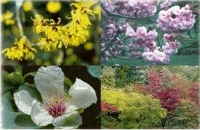Washington State Arboretum
Washington Park Arboretum

Adopted in 1995
The Washington park arboretum is designated as an official arboretum of the state of Washington in 1995
The Washington Park Arboretum, has had a glorious sixty-plus year history as one of the most loved educational and cultural resources in the Pacific Northwest. The Arboretum, then known as the University of Washington Arboretum, began officially in 1934 when an agreement was signed by the University of Washington and the City of Seattle, allowing the University to develop and manage an arboretum and botanical garden in Washington Park. This agreement continues to serve the park's and arboretum's mission of service to the people of the Northwest, through education, conservation and recreation.
The Washington Park Arboretum is managed cooperatively by the Seattle Department of Parks and Recreation and the University of Washington. The Arboretum Foundation is its major support organization. The City of Seattle owns the Arboretum's land (except for small portions at the north end) and buildings, Seattle Parks and Recreation maintains the park functions and the University of Washington maintains and manages the plant collections and outreach programs. Development of the Arboretum Master Plan will not alter this relationship.
Washington State Arboretum:
Washington Park Arboretum
History
The Washington Park Arboretum was established in 1934 by an agreement approved by both the University of Washington (Board of Regents) and the City of Seattle (City Council/Mayor). The City of Seattle held title to a 200+ acre park known as Washington Park located in a central portion of the city. It agreed that the University could design, construct, plant, and manage an Arboretum and Botanical Garden in this park. The Arboretum Foundation was founded in 1935 and has been an active support group ever since.
In 1936, the Seattle Garden Club donated $3000 to hire James F. Dawson and Frederick Law Olmsted, Jr. of the Olmsted Brothers landscape firm to design the first planting plan. Mr. Dawson was the chief designer of the plan. During those early years when the nation was in deep depression, 500 men in the Public Works Administration constructed many of the historical features; e.g., the Stone Cottage, and Azalea Way. The Dawson plan followed the typical phylogenetic progression of families from primitive to advanced, as accepted in that day.
However, the majority of the accessions to the collections occurred during the years after World War II, when the late Brian O. Mulligan was director. His modifications to the original design led to many plants being culturally better sited, and gardens, such as the Winter and Woodland Gardens, with an emphasis on design focus.
During the 1970's, disagreements arose regarding the roles and interests of the University, the City, and the Arboretum's immediate neighborhood. As a result, the University and City negotiated a more detailed working partnership, summarized in 1974 in a Letter of Clarification to the 1934 Agreement. In 1980, the University reaffirmed its managerial role by establishing the Center for Urban Horticulture (CUH) at Union Bay, at a campus site only 1.5 miles from the Arboretum. Establishment of the Center, to provide physical facilities, programs, and staff that could not be accommodated within the Arboretum grounds, was essential to fulfilling its larger mission, and was mandated by the 1978 Master Plan Update. Today, the Center holds management responsibility through the College of Forest Resources for the Arboretum who have continued to clarify and expand the Arboretum's aims and programs.
In the late 1980's, discussion intensified about the future of the Arboretum itself, including the need for a new strategic Master Plan. A new collections policy had been enacted, the educational and interpretation programs were greatly expanded, new facilities at both the Union Bay and Arboretum sites had been constructed, and the use of the plant collections by the University and other area educational institutions had greatly increased. The age of the collections, the location within an affluent urban area and the need for diversification of public programs were key elements for future planning.
Washington Law
The law designating the Washington park arboretum as the official Washington state arboretum is found in the Revised Code of Washington, Title 1, Chapter 1.20, Section 1.20.120.
Chapter 1.20 RCW
Title 1 GENERAL PROVISIONS
RCW 1.20.120
State arboretum.
The Washington park arboretum is hereby designated as an official arboretum of the state of Washington.
[1995 c 82 § 2.]
NOTES:
Findings - 1995 c 82: "The legislature finds that the arboreta in this state act as living museums devoted to the display and conservation of woody
plant species from around the world that can grow in the Pacific Northwest. Arboreta enhance public appreciation for the aesthetic diversity of temperate
woody plants; conserve both natural and cultivated woody plant taxa to preserve their diversity for future appreciation; educate the public and students
concerning urban landscape use and the natural biology of temperate woody plants; and cooperate with similar institutions in this region and around
the world in achieving these common goals. The legislature further finds that arboreta are of increasing importance as world biodiversity declines.
The Washington park arboretum is a two hundred acre living museum that is managed cooperatively by the city of Seattle and the University of Washington.
It is devoted to the display and conservation of collections of plants from around the world which can grow in the Pacific Northwest. These plants
are used for education, research, conservation, and a sense of public pleasure. The Washington park arboretum, the oldest center for botanical and
gardening learning in the Pacific Northwest, is recognized as one of the two foremost collections of woody plants in the United States of America and
enjoys an excellent international reputation. The legislature finds that it is fitting and appropriate to recognize the importance of the overall mission
of the Washington park arboretum." [1995 c 82 § 1.]








